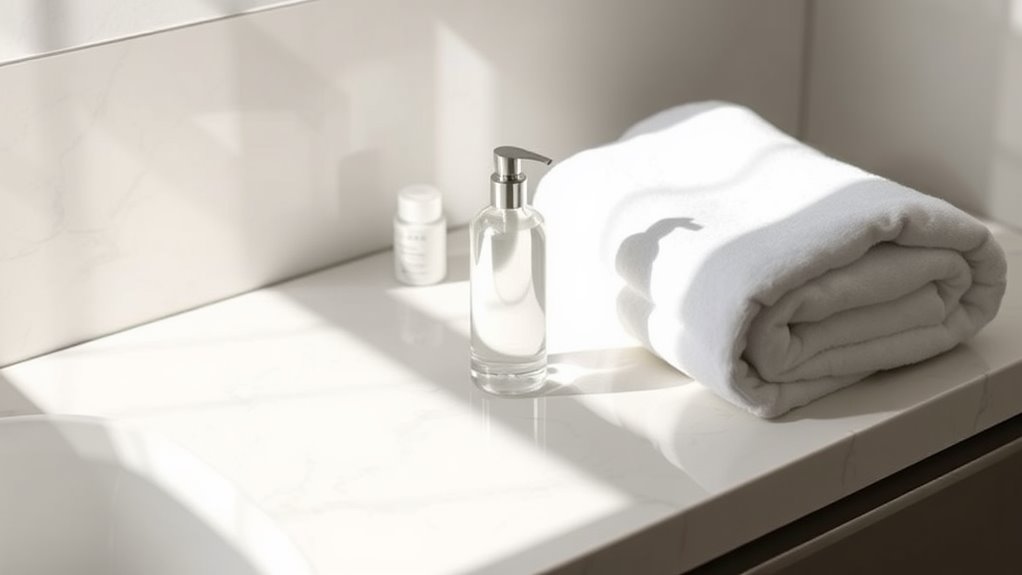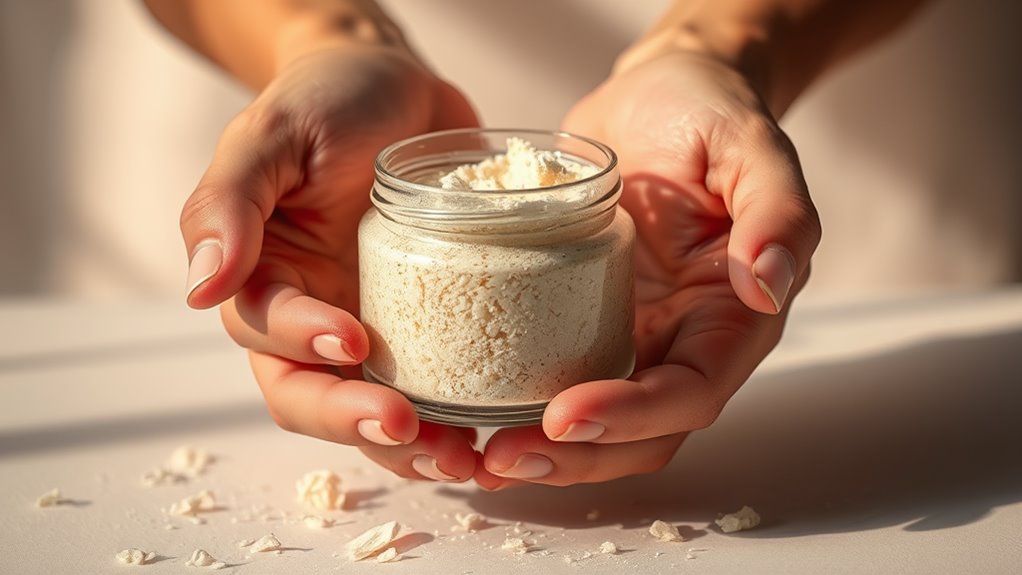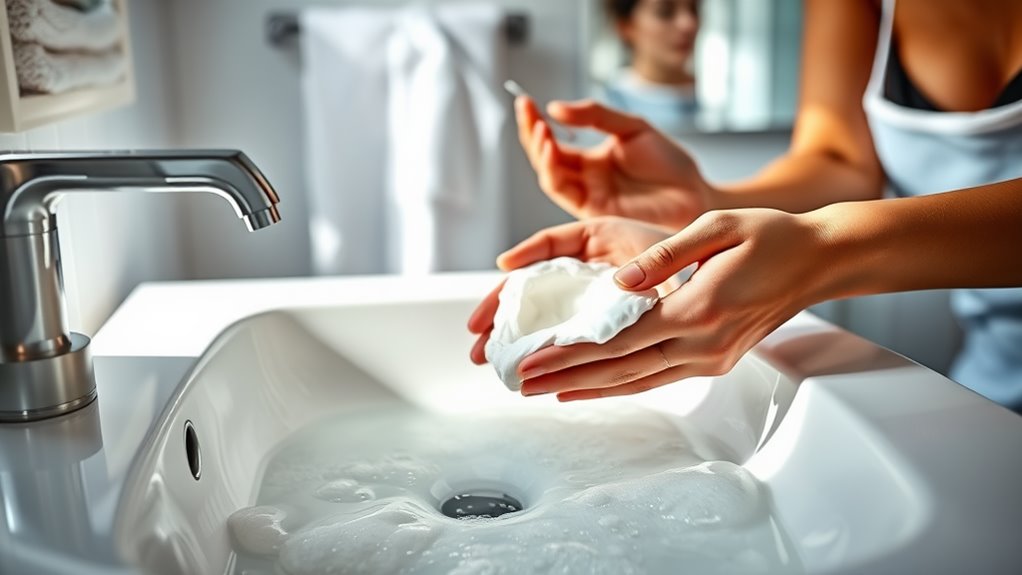One Exfoliation Method That Works for Every Skin Type
Lactic acid is the universal exfoliation method that works for every skin type. It gently promotes cell turnover, enhancing radiance without causing irritation. This AHA is particularly beneficial for sensitive skin, making it suitable for normal, oily, or dry complexions alike. With regular use, you can achieve clearer pores and a smoother texture. By incorporating lactic acid into your routine, you’ll foster healthy skin. Discover how to optimize your exfoliation routine for the best results.
Key Takeaways
- Enzymatic exfoliation is gentle and suitable for all skin types, utilizing natural fruit enzymes to dissolve dead skin cells without irritation.
- This method minimizes the risk of over-exfoliation, making it ideal for sensitive skin while still promoting cell turnover.
- Enzymatic exfoliants enhance product absorption, benefiting all skin types by ensuring deeper penetration of skincare ingredients.
- Regular use, about once a week, can help maintain a smooth and radiant complexion across different skin types.
- Look for biodegradable or natural enzymatic products to ensure a gentle yet effective exfoliation experience for every skin type.
Understanding Exfoliation
Exfoliation is a crucial step in any skincare routine, as it helps remove dead skin cells and promotes cell turnover.
Understanding exfoliation requires recognizing its two primary methods: physical and chemical. Physical exfoliation utilizes granular products to manually slough off dead skin, while chemical exfoliation employs acids or enzymes to dissolve cellular bonds.
A universal exfoliation tip is to tailor your approach based on your skin type; for example, sensitive skin may benefit from gentle chemical exfoliants, whereas oily skin might respond well to stronger acids.
Regular exfoliation, ideally 1-3 times per week, enhances product absorption and reveals a smoother complexion. Neglecting this step can lead to rough and uneven skin texture, highlighting its importance in maintaining healthy skin.
Mastering this technique can significantly improve your skin’s overall health and appearance.
The Importance of Exfoliation
While many may overlook it, exfoliation plays a vital role in maintaining healthy skin. By regularly removing dead skin cells, you promote cellular turnover, which leads to a brighter, more even complexion.
Here are three key reasons why you shouldn’t skip exfoliation:
-
Enhanced Absorption: Exfoliation clears the way for your skincare products, allowing them to penetrate deeper and work more effectively.
-
Clogged Pores Prevention: Regularly sloughing off dead skin helps prevent pore blockages, reducing the likelihood of acne and breakouts.
-
Youthful Appearance: By stimulating collagen production, exfoliation helps diminish fine lines and wrinkles, giving your skin a more youthful look. However, it’s important to note that over-exfoliating your skin can lead to irritation and barrier damage, so finding a balanced routine is crucial.
Incorporating exfoliation into your routine is essential for achieving and maintaining optimal skin health.
Different Skin Types Explained
Understanding your skin type is crucial for selecting the right exfoliation method. Skin types generally fall into four categories: normal, oily, dry, and combination.
Normal skin maintains a balanced texture, with minimal sensitivity. Oily skin produces excess sebum, often leading to enlarged pores and acne. Dry skin lacks moisture, resulting in flakiness and tightness. Combination skin exhibits characteristics of two or more types, typically oily in the T-zone and dry on the cheeks.
Each skin type responds differently to exfoliation techniques. Therefore, recognizing your unique skin type allows you to choose an appropriate exfoliation approach that maximizes benefits while minimizing irritation. Additionally, selecting the right cleanser for your skin type can further enhance your exfoliation results and overall skincare routine.
Mastering this knowledge ultimately enhances your skincare routine and promotes healthier skin.
Common Exfoliation Methods
When it comes to maintaining healthy skin, knowing the common exfoliation methods can significantly enhance your skincare routine.
Each method serves a unique purpose and can cater to different skin types. Here are three primary exfoliation techniques you should consider:
-
Physical Exfoliation: This method uses scrubs or tools to manually remove dead skin cells, offering immediate results and a polished appearance.
-
Chemical Exfoliation: Utilizing acids like AHAs or BHAs, this method breaks down the bonds holding dead skin cells together, promoting cell turnover and a smoother texture.
-
Enzymatic Exfoliation: Derived from fruits, this gentle method uses natural enzymes to dissolve dead skin, making it ideal for sensitive skin. This technique is particularly beneficial for achieving a smooth, radiant complexion without irritation.
Understanding these methods empowers you to choose the right one for your specific needs.
Why Choose a Universal Method
Choosing a universal exfoliation method can simplify your skincare routine while effectively addressing diverse skin concerns. This approach eliminates the need for multiple products tailored to specific skin types, reducing the potential for irritation and product overload.
A universal method often balances chemical and physical exfoliants, ensuring that it can cater to oily, dry, sensitive, and combination skin without compromising efficacy. By using a single, well-formulated product, you can streamline your regimen, save time, and minimize costs.
Additionally, a universal method promotes skin health by enhancing cellular turnover, improving texture, and encouraging a brighter complexion. Embracing this strategy allows you to master exfoliation, achieving optimal results regardless of your skin’s unique characteristics. Moreover, daily exfoliating can help prevent common mistakes such as over-exfoliation, ensuring your skin remains healthy and radiant.
The Ideal Exfoliation Technique
Exfoliation offers numerous benefits, including improved skin texture and enhanced product absorption.
To maximize these advantages, it’s crucial to choose the right method tailored to your skin type.
Understanding your skin’s needs will guide you in selecting an effective exfoliation technique that promotes health and radiance.
Benefits of Exfoliation
Although many overlook it, understanding the benefits of exfoliation is crucial for achieving healthy skin. Regular exfoliation enhances your skin’s texture and tone, promoting a radiant complexion. It helps eliminate dead skin cells, allowing fresh ones to surface.
Here are three key benefits:
-
Improved Absorption: Exfoliating clears away buildup, enabling your skin care products to penetrate deeper and work more effectively.
-
Stimulated Cell Renewal: It encourages the natural turnover of skin cells, helping to reduce fine lines and blemishes.
-
Enhanced Circulation: The process boosts blood flow, delivering essential nutrients and oxygen to your skin, which contributes to a healthy glow.
Incorporating exfoliation into your routine can significantly elevate your skin’s overall health and appearance.
Choosing the Right Method
When selecting the ideal exfoliation technique, it’s essential to consider your skin type and specific concerns. Different methods—physical, chemical, and enzymatic—offer varying benefits tailored to distinct needs.
| Skin Type | Recommended Method | Frequency |
|---|---|---|
| Oily | Chemical (BHA) | 2-3 times/week |
| Dry | Enzymatic | 1-2 times/week |
| Sensitive | Physical (Gentle Scrub) | 1 time/week |
| Combination | Chemical (AHA) | 2 times/week |
Step-by-Step Guide to Exfoliation
To achieve optimal results from your exfoliation routine, it’s essential to follow a structured approach tailored to your skin type.
Begin by identifying your skin’s specific needs. Here’s a simple guide:
-
Cleanse: Start with a gentle cleanser to remove dirt and oil, preparing your skin for effective exfoliation.
-
Exfoliate: Apply your chosen exfoliant using circular motions, allowing it to work for the recommended time. Avoid over-exfoliating; moderation is key.
-
Moisturize: After rinsing, apply a hydrating moisturizer to replenish moisture and protect your skin barrier.
Following these steps will ensure you maximize the benefits of exfoliation while minimizing irritation, leading to a smoother, more radiant complexion.
Mastering this process will elevate your skincare routine.
Recommended Products for All Skin Types
Finding the right exfoliation products for your skin type can significantly enhance your skincare routine.
For all skin types, consider a gentle, pH-balanced chemical exfoliant containing alpha-hydroxy acids (AHAs) like glycolic acid. This promotes cell turnover without excessive abrasion.
If you have sensitive skin, opt for a product with lactic acid, which is milder yet effective.
For oily or acne-prone skin, salicylic acid is ideal, as it penetrates pores to clear congestion.
Look for scrubs that use biodegradable microbeads or natural exfoliants like jojoba beads for a physical option.
Always perform a patch test before full application to gauge your skin’s response.
Prioritize formulations free of sulfates and parabens to maintain skin integrity and health.
How Often to Exfoliate
Exfoliation frequency plays a vital role in maximizing the benefits of the products you’ve chosen. To achieve optimal results, consider the following guidelines:
-
Oily Skin: Exfoliate 2-3 times a week. This helps control excess oil while preventing clogged pores.
-
Dry or Sensitive Skin: Exfoliate once a week. This gentle approach maintains moisture balance without irritation.
-
Combination Skin: Exfoliate 1-2 times a week. Tailor your routine to address both oily and dry areas effectively.
Signs of Over-Exfoliation
Three key signs indicate you may be over-exfoliating your skin.
First, if you notice persistent redness or irritation, your skin’s barrier is likely compromised.
Second, excessive dryness or flakiness can signal that you’ve stripped away essential oils, leading to dehydration.
Third, an increase in breakouts might occur as your skin overproduces oil in response to irritation.
Each of these symptoms reflects an imbalance that can hinder skin health.
If you experience any of these signs, it’s crucial to reassess your exfoliation routine.
Consider scaling back on frequency or switching to a gentler method.
Mastering exfoliation requires listening to your skin’s signals, ensuring you maintain a healthy balance while achieving your desired results.
Maintaining a Healthy Skin Barrier
Your skin barrier plays a crucial role in protecting against environmental stressors and retaining moisture.
Recognizing the signs of barrier damage, such as increased sensitivity or dryness, is essential for maintaining skin health.
Implementing targeted repair strategies can help restore your barrier’s function effectively.
Importance of Skin Barrier
The skin barrier acts as the body’s first line of defense against environmental stressors, pathogens, and moisture loss. Understanding its importance is crucial for maintaining overall skin health.
A robust skin barrier enables:
-
Protection: It shields your skin from harmful pollutants and harmful microorganisms.
-
Hydration: A healthy barrier prevents transepidermal water loss, keeping your skin plump and moisturized.
-
Balance: It maintains the skin’s natural pH, supporting beneficial bacteria while repelling irritants.
When you prioritize your skin barrier, you empower your skin to function optimally.
This foundation allows you to effectively utilize exfoliation methods and other treatments, enhancing your skincare routine.
Mastering skin barrier maintenance is essential for achieving and sustaining vibrant, resilient skin.
Signs of Damage
Recognizing the signs of a damaged skin barrier is vital for maintaining healthy skin. You may notice increased sensitivity, characterized by redness, itching, or burning sensations.
Dryness and flakiness often accompany barrier impairment, as the skin struggles to retain moisture. Additionally, you might observe breakouts or irritation, resulting from the skin’s compromised ability to fend off bacteria and pollutants.
A dull complexion can also signal barrier damage, as a lack of proper exfoliation and hydration leads to a build-up of dead skin cells.
Finally, if you find that products sting or irritate your skin, this could indicate a weakened barrier. Identifying these signs early allows for proactive measures to restore your skin’s health.
Tips for Repairing
To effectively repair and maintain a healthy skin barrier, prioritize hydration and gentle care. The integrity of your skin relies on a balanced approach, so consider these essential tips:
-
Moisturize Daily: Use a humectant-rich moisturizer to attract and retain moisture, minimizing transepidermal water loss.
-
Limit Exfoliation: Reduce the frequency of exfoliation to prevent further barrier disruption; aim for once a week.
-
Incorporate Barrier-Repair Ingredients****: Look for products containing ceramides, fatty acids, and niacinamide, which strengthen the skin’s natural defenses.




